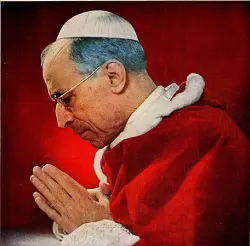Maundy Thursday At The Brompton Oratory
The Church was packed.
The celebration was extremely reverent.
The music was breathtaking – and inspiring – as always.
I haven’t spotted any woman among the viri selecti; who were, I assure you, all belonging to the Christian faith.
The photos are here.
Mundabor
Posted on March 30, 2013, in Catholicism and tagged Brompton Oratory, Conservative Catholic, conservative catholicism. Bookmark the permalink. 7 Comments.





















I keen for the days when the Oratory was close at hand.
Magnificent as always.
“Glory to God, who framed a Saint, So beautiful and sweet;
Who brought him from St. Peter’s side And placed us at his feet.”
(Fr. Faber)
One seriously wonders how long it will be until the splendid liturgical habits of the Oratorians are criticised as being too “prideful”.
M
Well, until someone conceives of Humility Inspectors to go around churches checking the sacristies for a suitable supply of Slabbinck vestments and tie-dyed stoles, I think we’re safe!
I jest, but you only need to look at St. Mary’s Pro-Cathedral in Dublin, a magnificent northern Baroque church much after the fashion of the Oratory to see what can happen if the Modernists get their claws in – Turnerelli’s magnificent reredos, the altar rails and the high altar were all torn out in the ’70s and ’80s, the pulpit now stands unused – unsurprisingly but shabbily almost immediately after the death of Abp. MacQuaid – I think we both agree he did not do enough, but he certainly detested the Franco-German ticket inspectors’ sons like Balthasar, Rahner, Congar and Lubac who were destroying the Faith at Vatican II and, for the whole of his reign, he insisted upon the silent Canon and the Roman chasuble, implementing the changes with a heavy heart and preserving what dignity, tradition and decorum he could. All of that is gone now, of course, as his successor, Dermot Ryan, was a raving Modernist whom MacQuaid actually dismissed from him post at the seminary!
What surprises me of many of these wreckovators is their absence of taste and sensibility for beauty and art. Philistines. Though many of them come from families where the art of Tiepolo and Tintoretto weren’t the subject of lunch discussions, the years in the seminary should have taught them better, surely?
As to Ratzinger, I agree he was against the liturgical demolition of the Sixties, but I do not think he ever distanced himself from his teacher Rahner. Some of the most outlandish ideas of Rahner – like the one that Christians may learn from atheists – was repeated by Ratzinger in a pretty similar way – talking of agnostics – during his papacy. The book “One Hundred Years Of Modernism” also attributes to Ratzinger the concept of “Permanent Revelation”, “issued from an ever-flowing source – the personal interpretation of the faithful- and erected into a supreme magisterium of the Church”. Scary stuff indeed, and all more or less derived by Rahner, who at the council tried to sabotage Tradition as a source of Revelation.
M
Cardinal Ratzinger? I was referring to the Irish Abp. MacQuaid, who was no Modernist, but those quotes are certainly interesting.
The revolting Karl Rahner (only the most egregious Modernist, of course, although a Rahner-Balthasar junta appears to be the theological norm for a ‘conservative’ (i.e. Modernist) prelate these days) posed a tremendous danger to the Faith – why was nothing done to arrest his (and the other New Theologians) dominance at the Council?
For goodness sake, an obscure Swiss priest expelled from the Jesuits in disgrace with a sham mystic in tow (Balthasar), a degenerate Jesuit disciplined by the Holy Office (Rahner, apparently he carried on an affair), a French expellee from Lyon (Lubac) and others were allowed to dictate to Princes of the Church! The sheer madness of the Council is quite crushing.
Ah, apologies, I have misread.
The question regarding how could it happen can in my eyes only be answered with the one about the smoke of Satan.
M